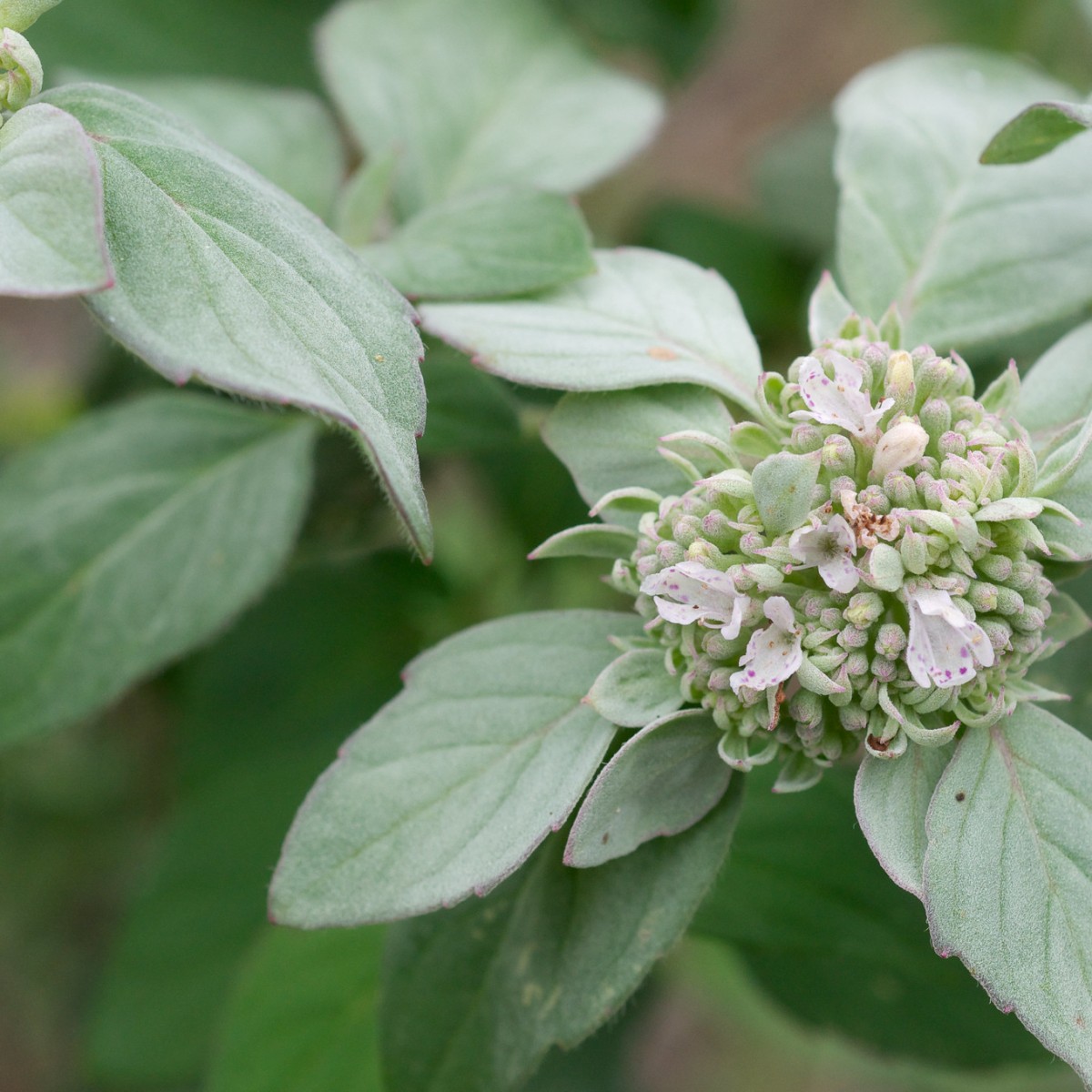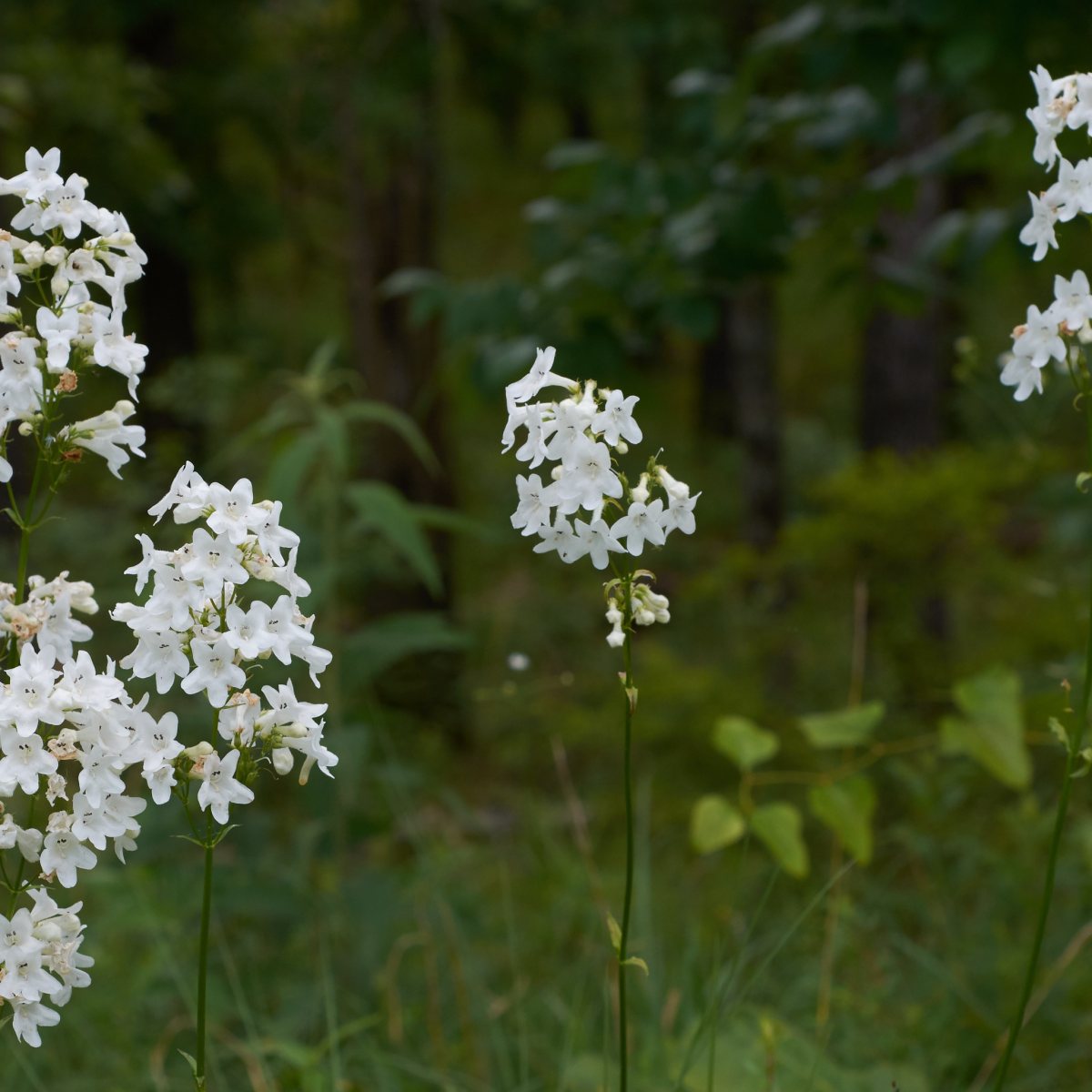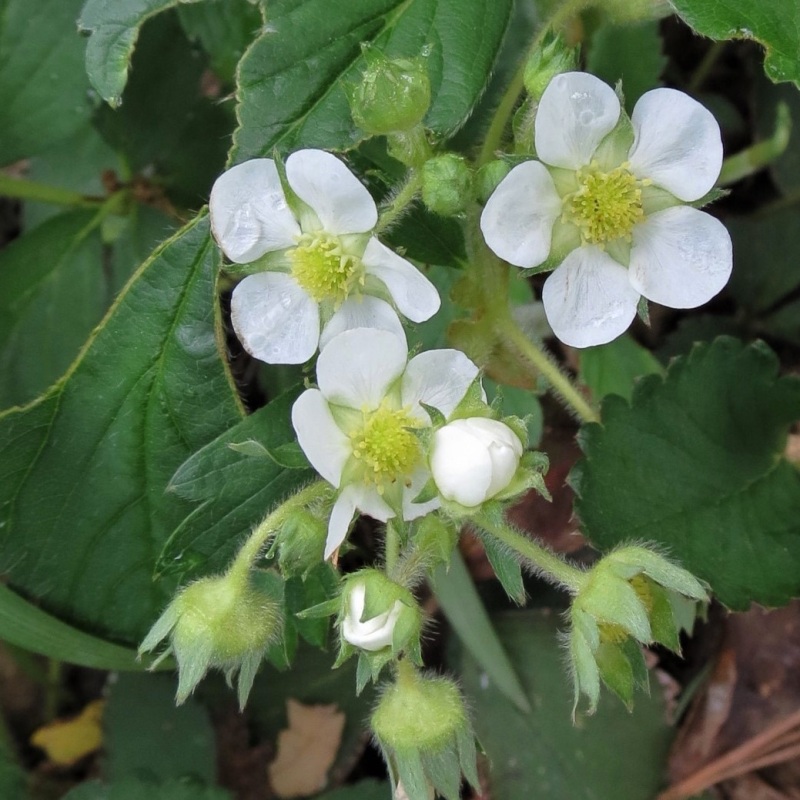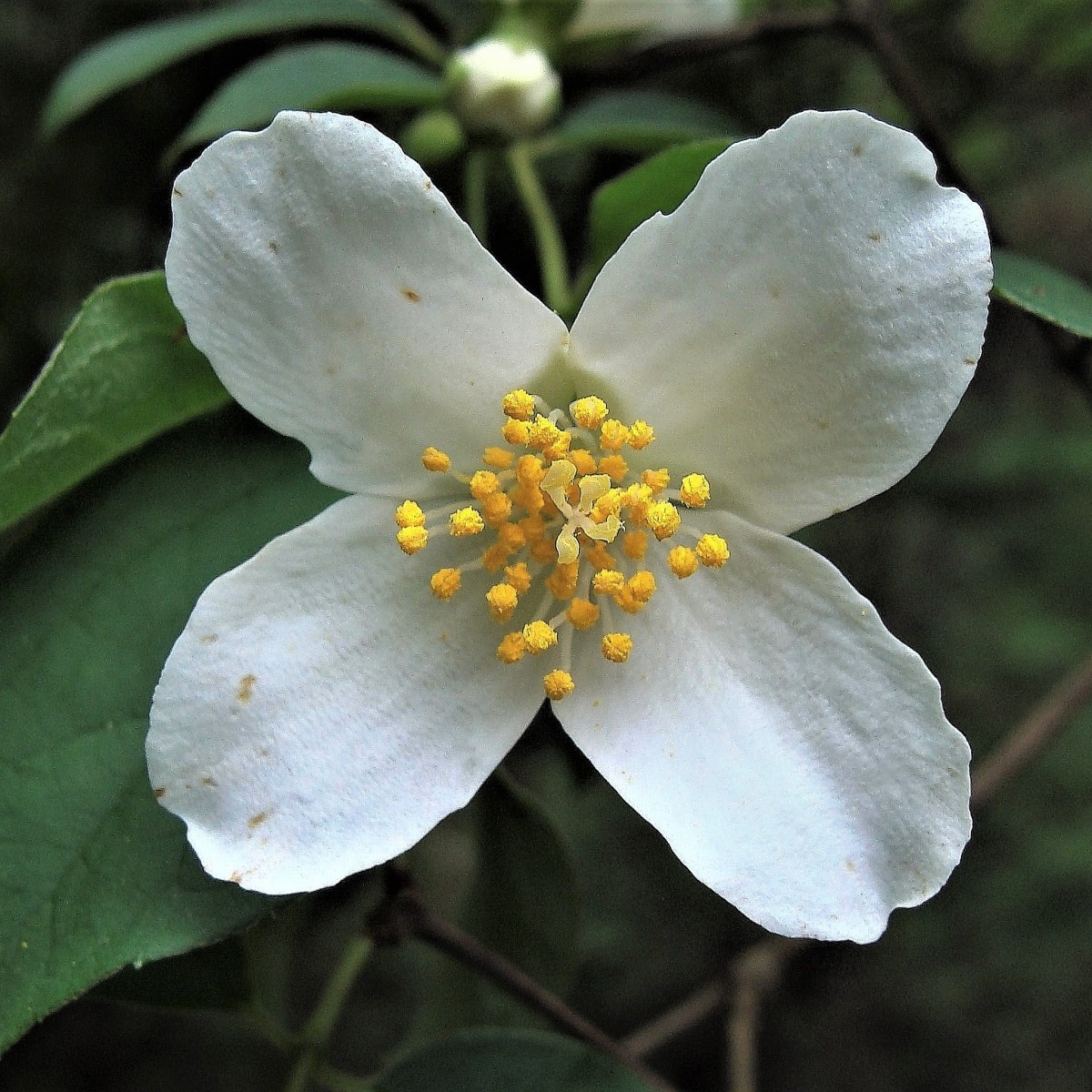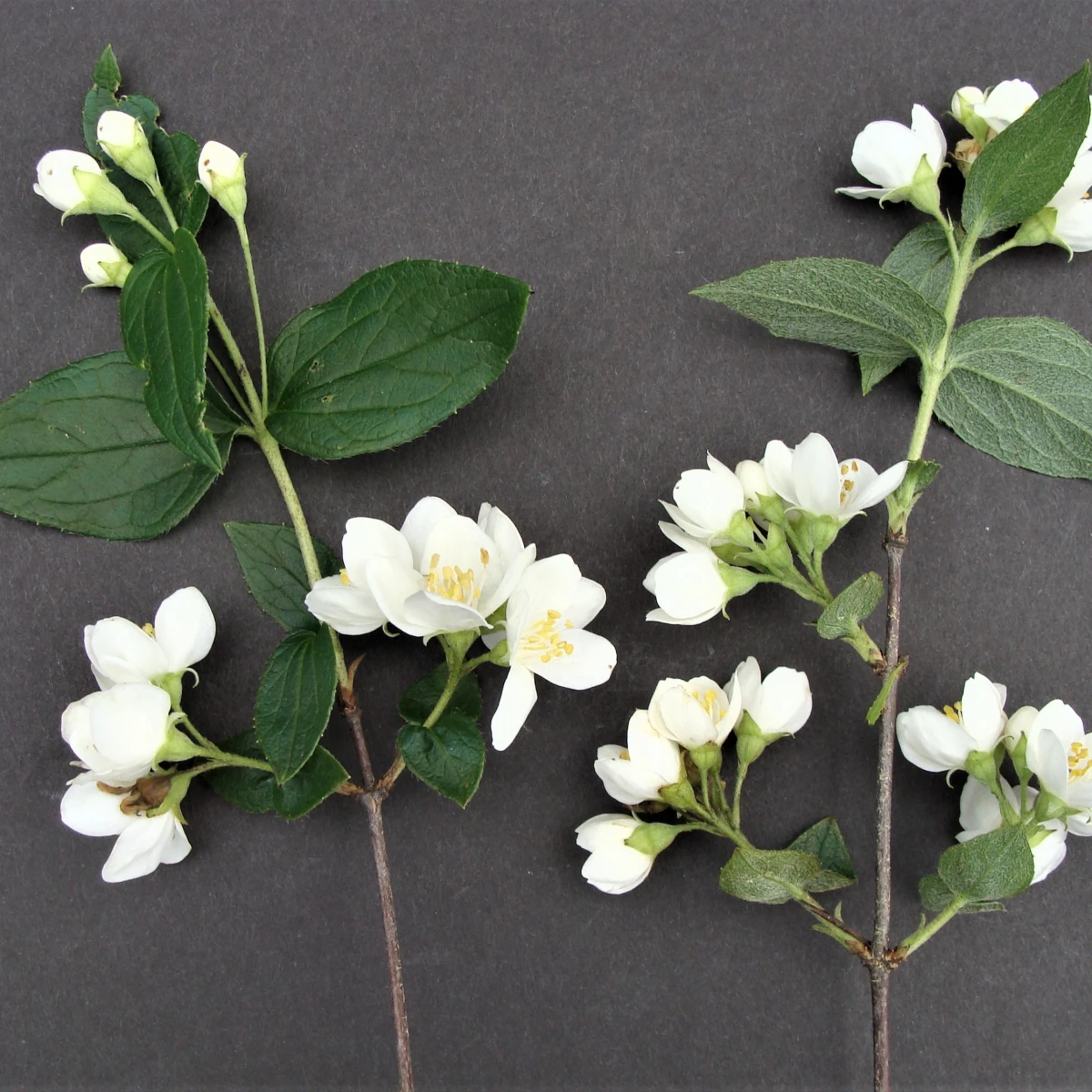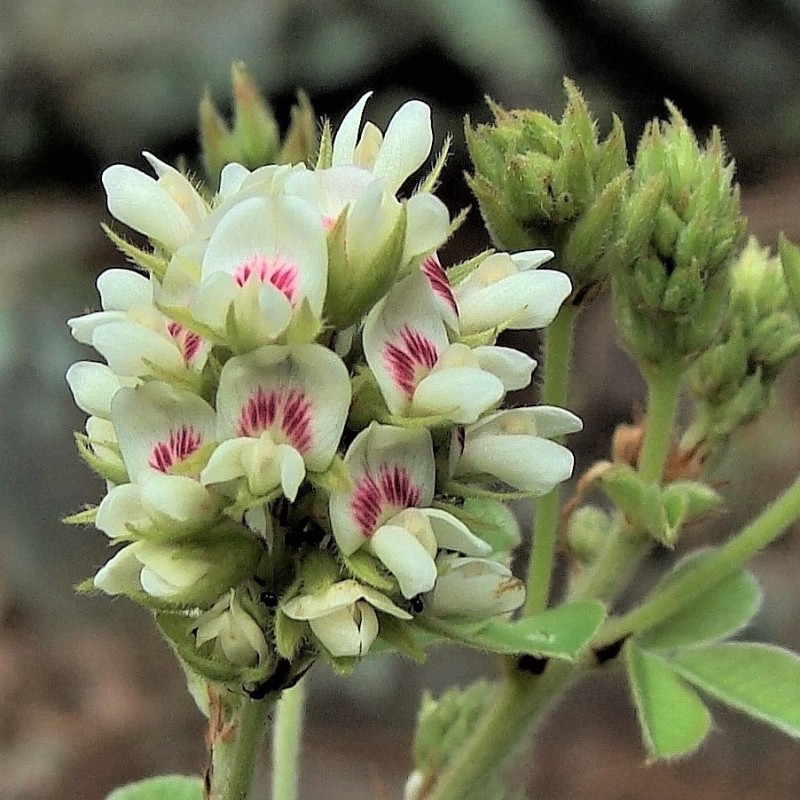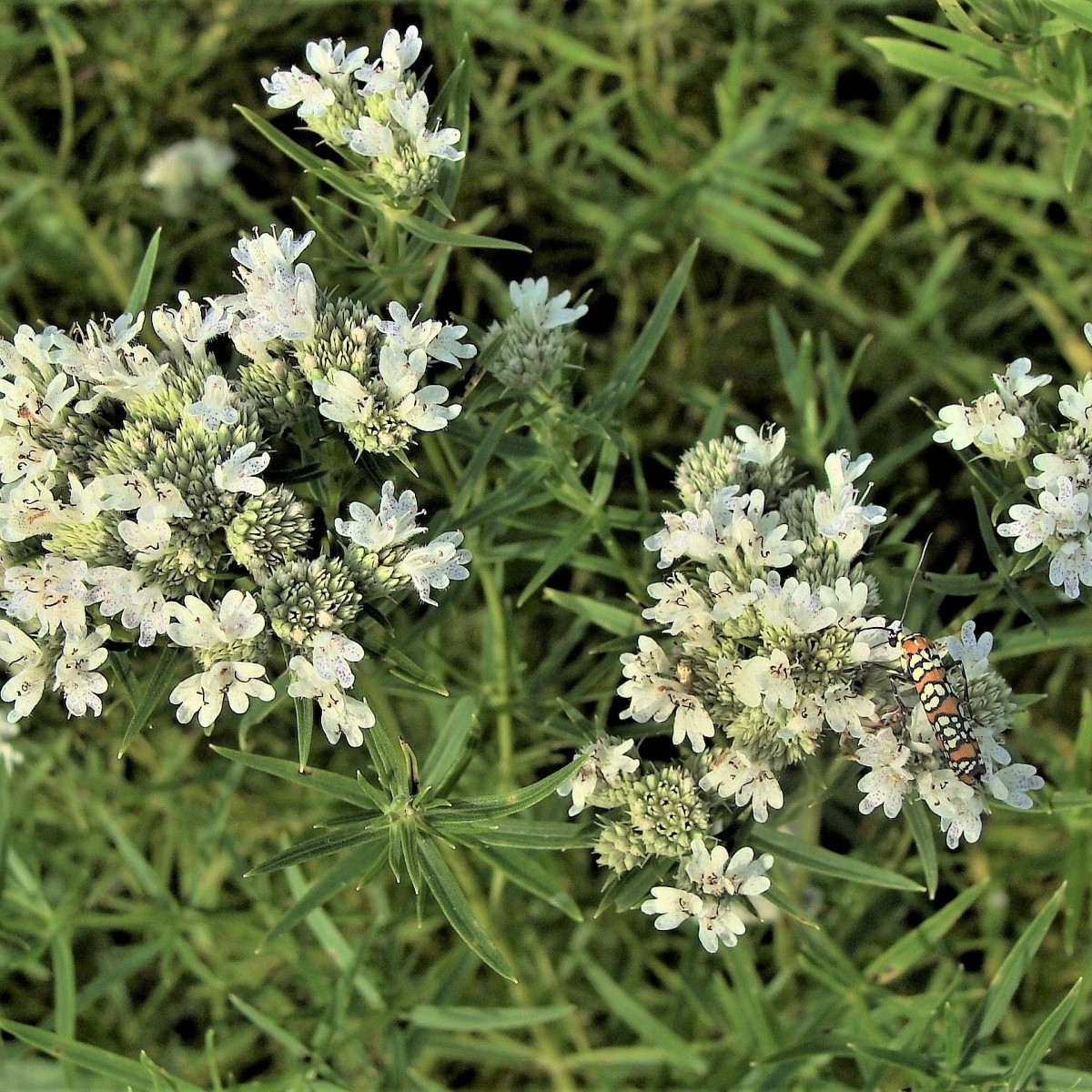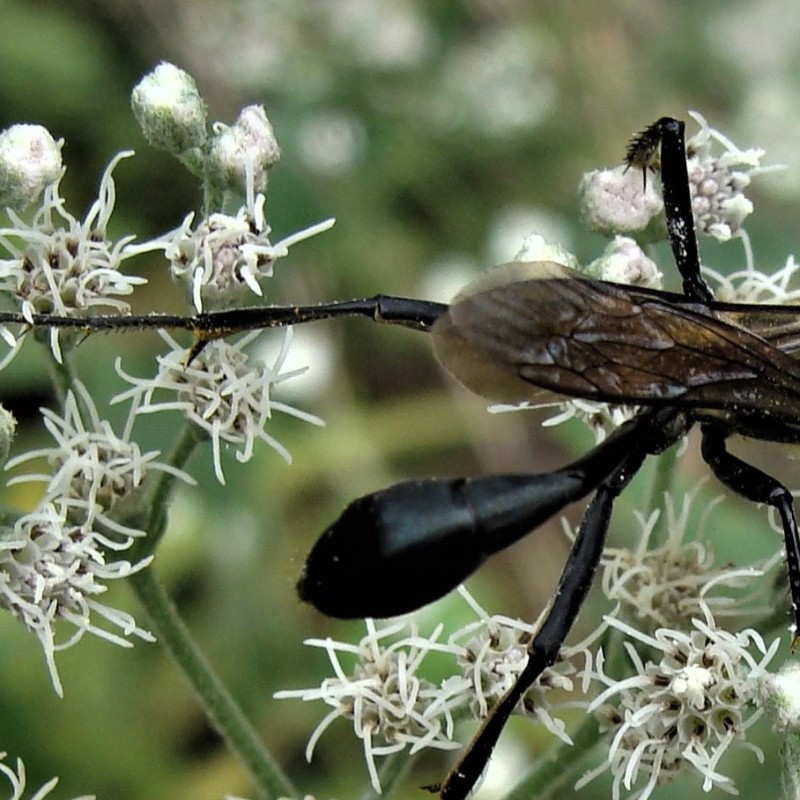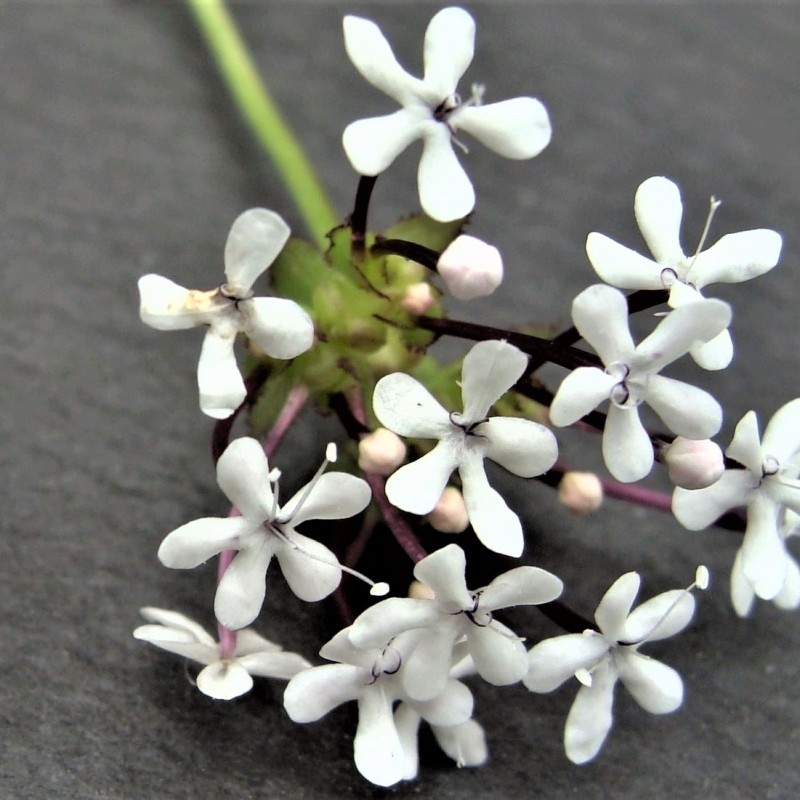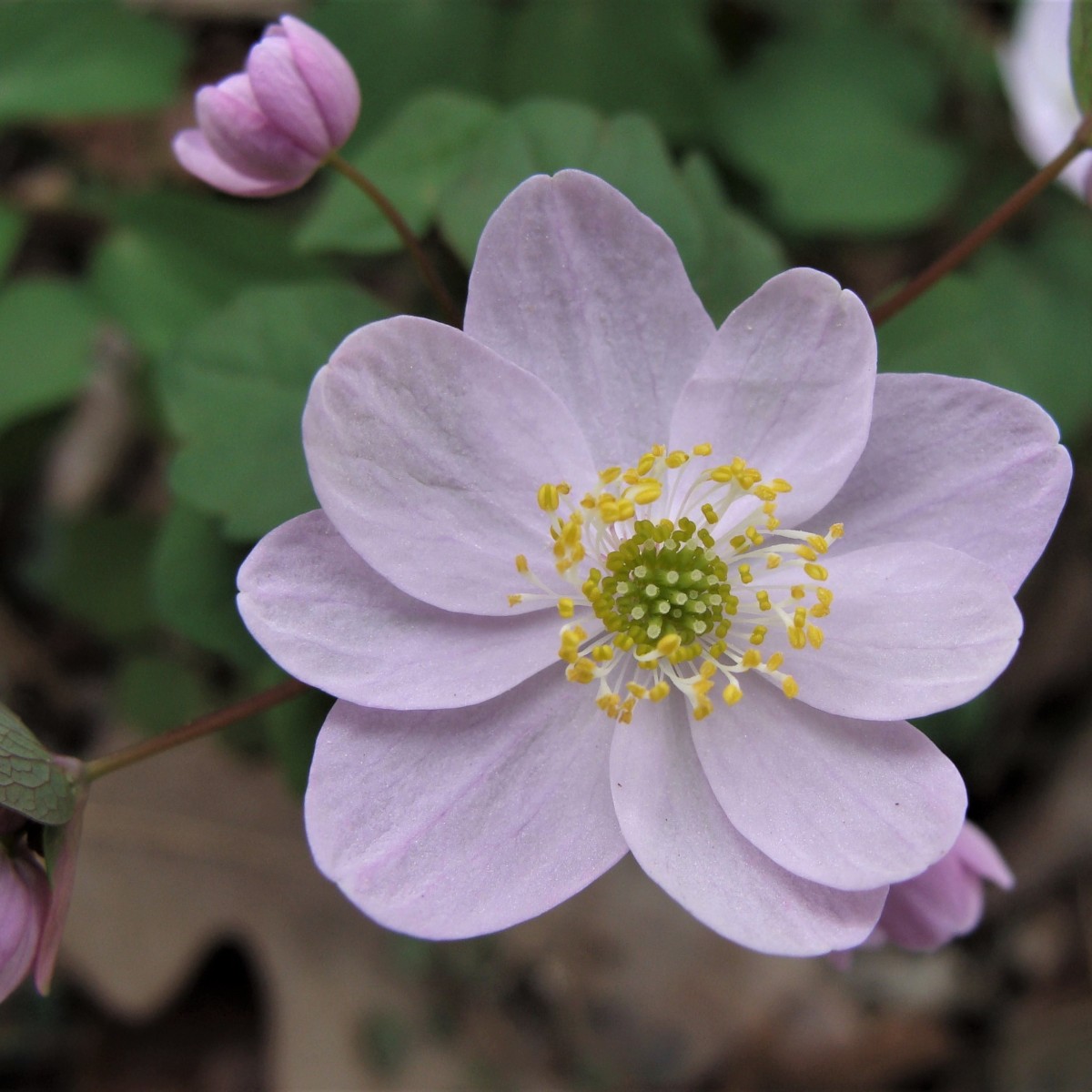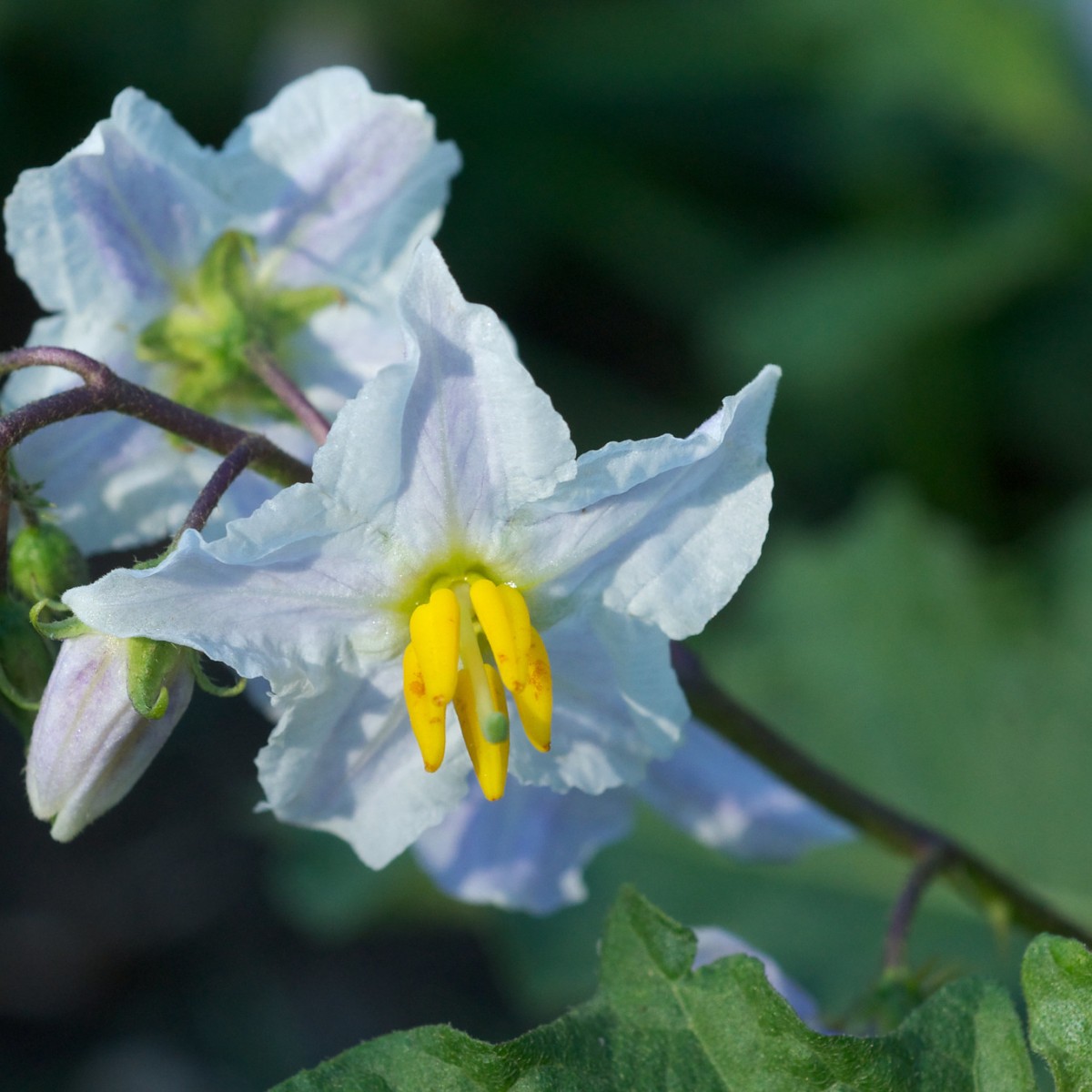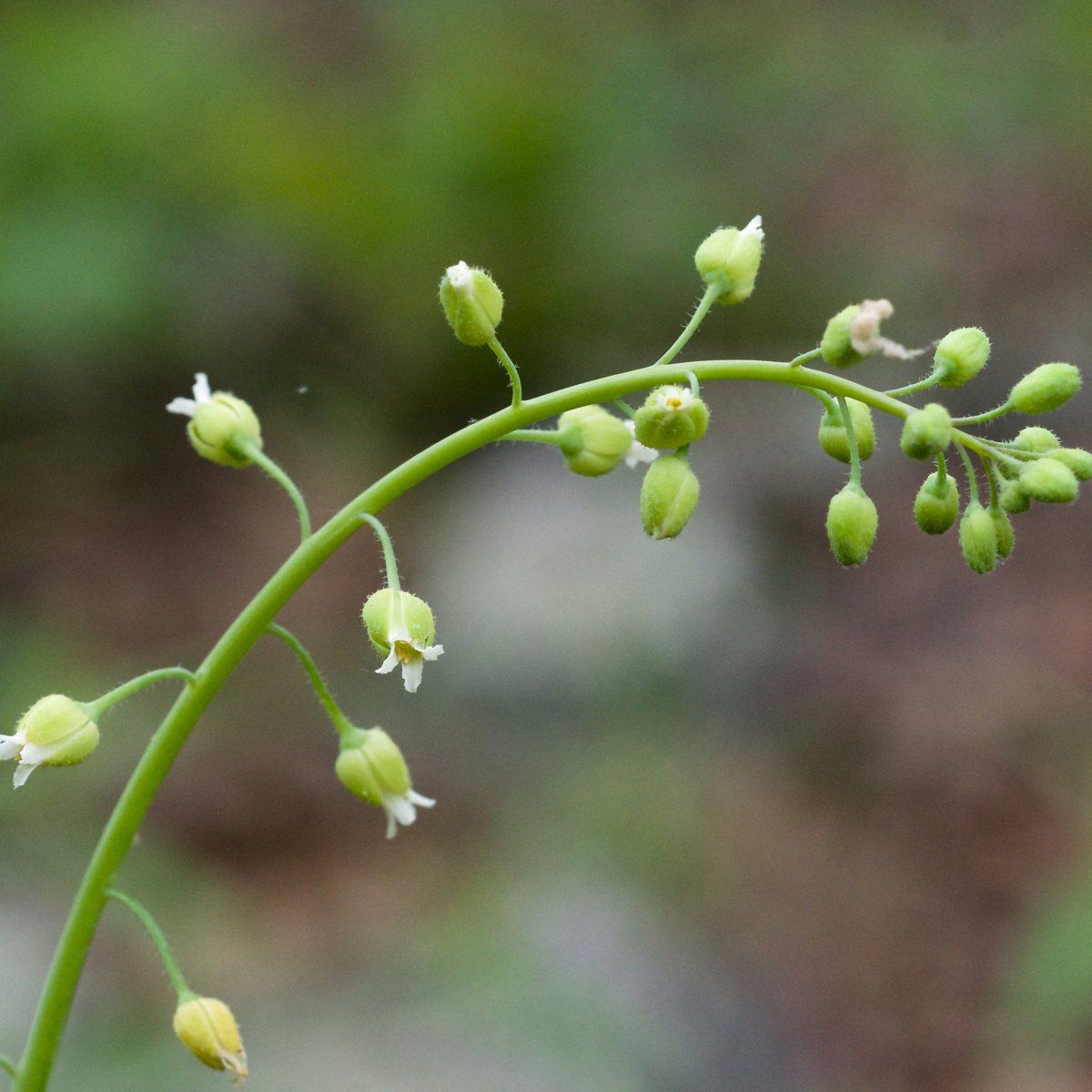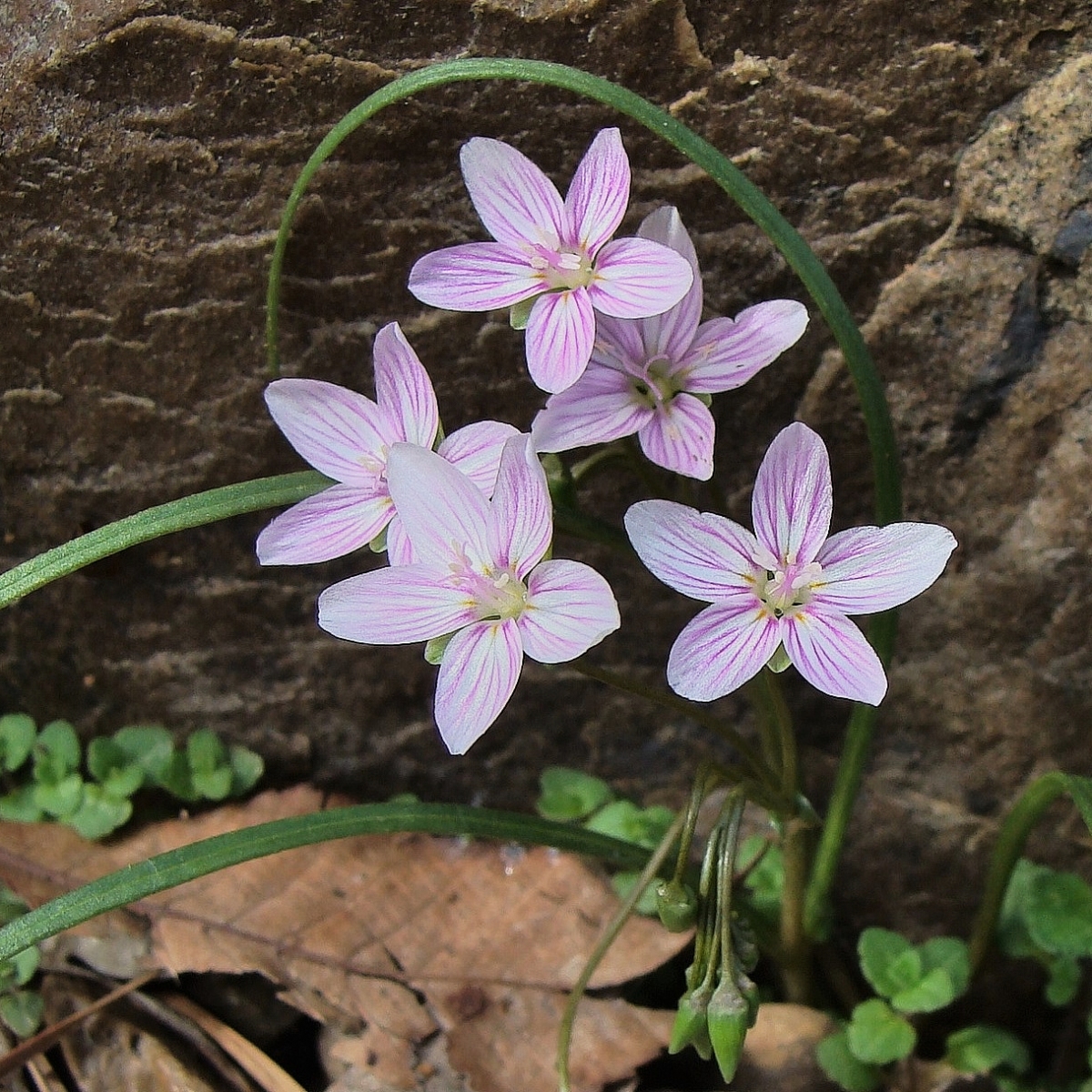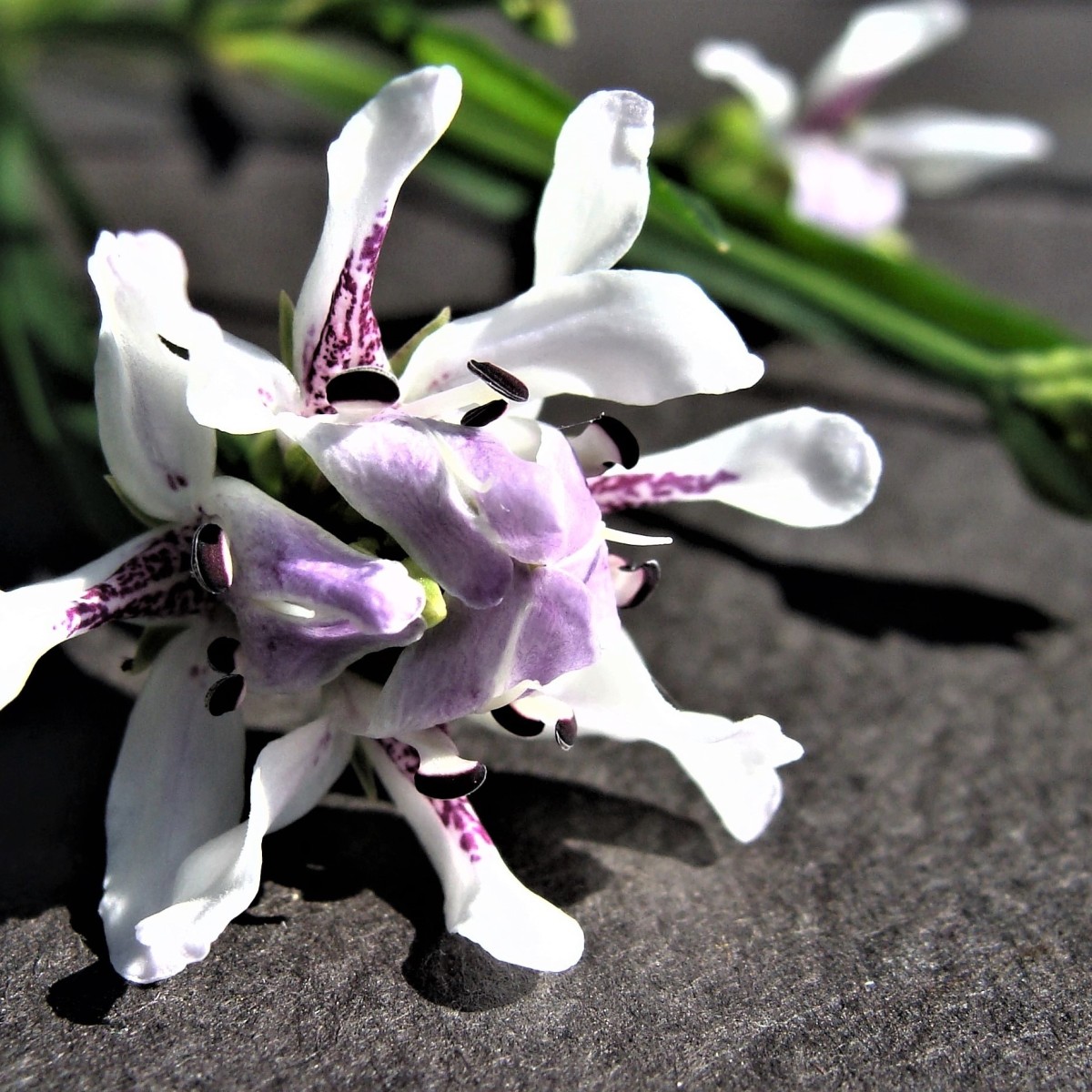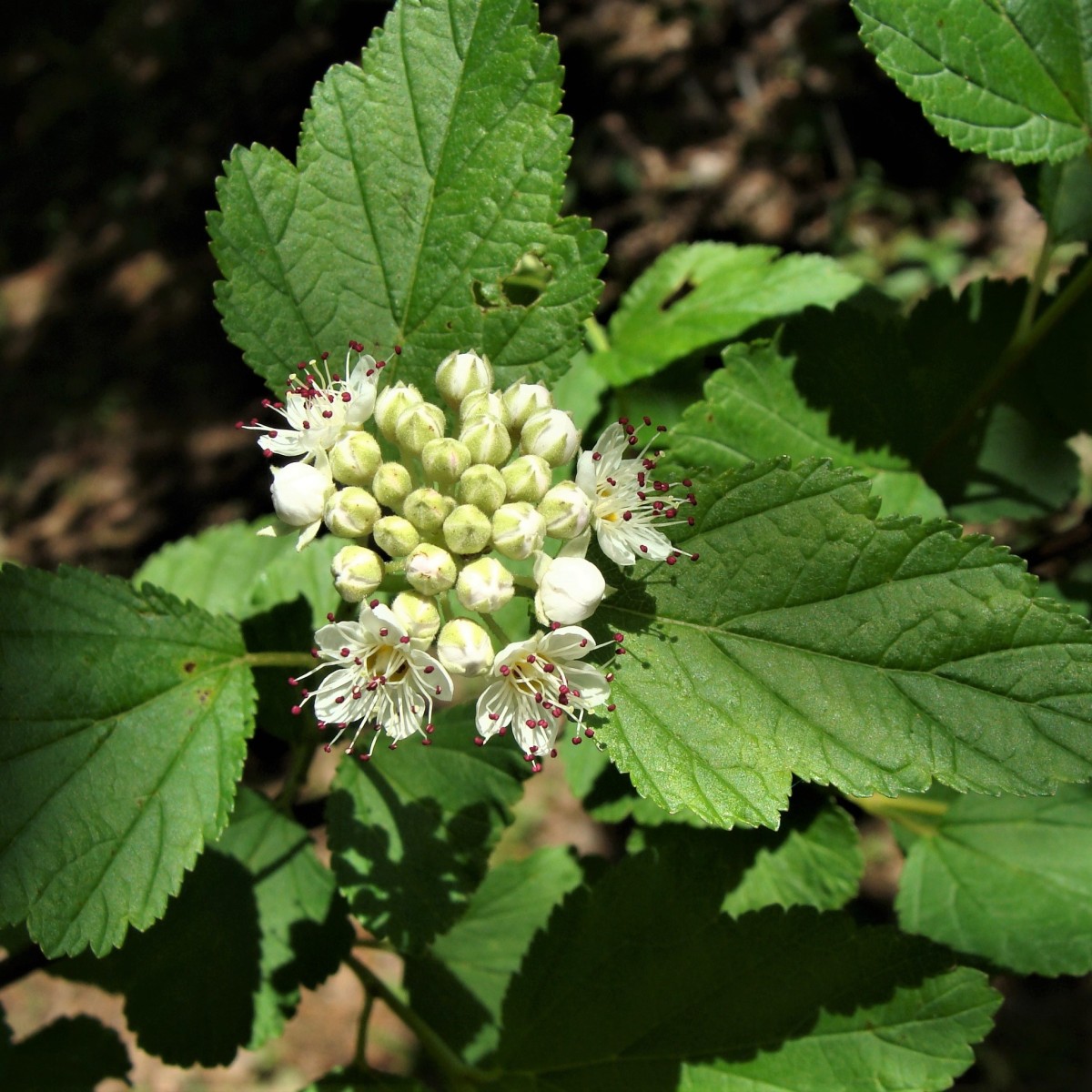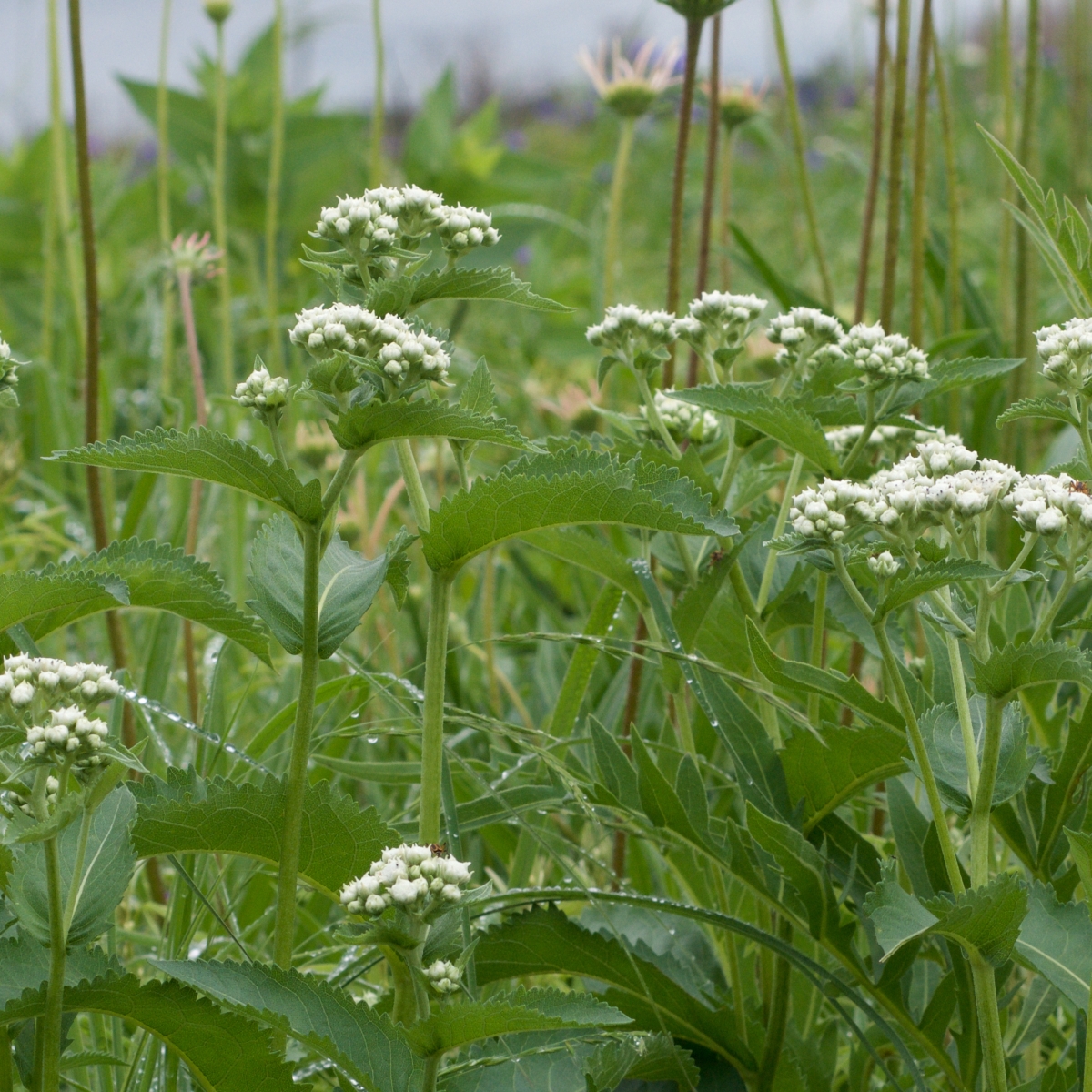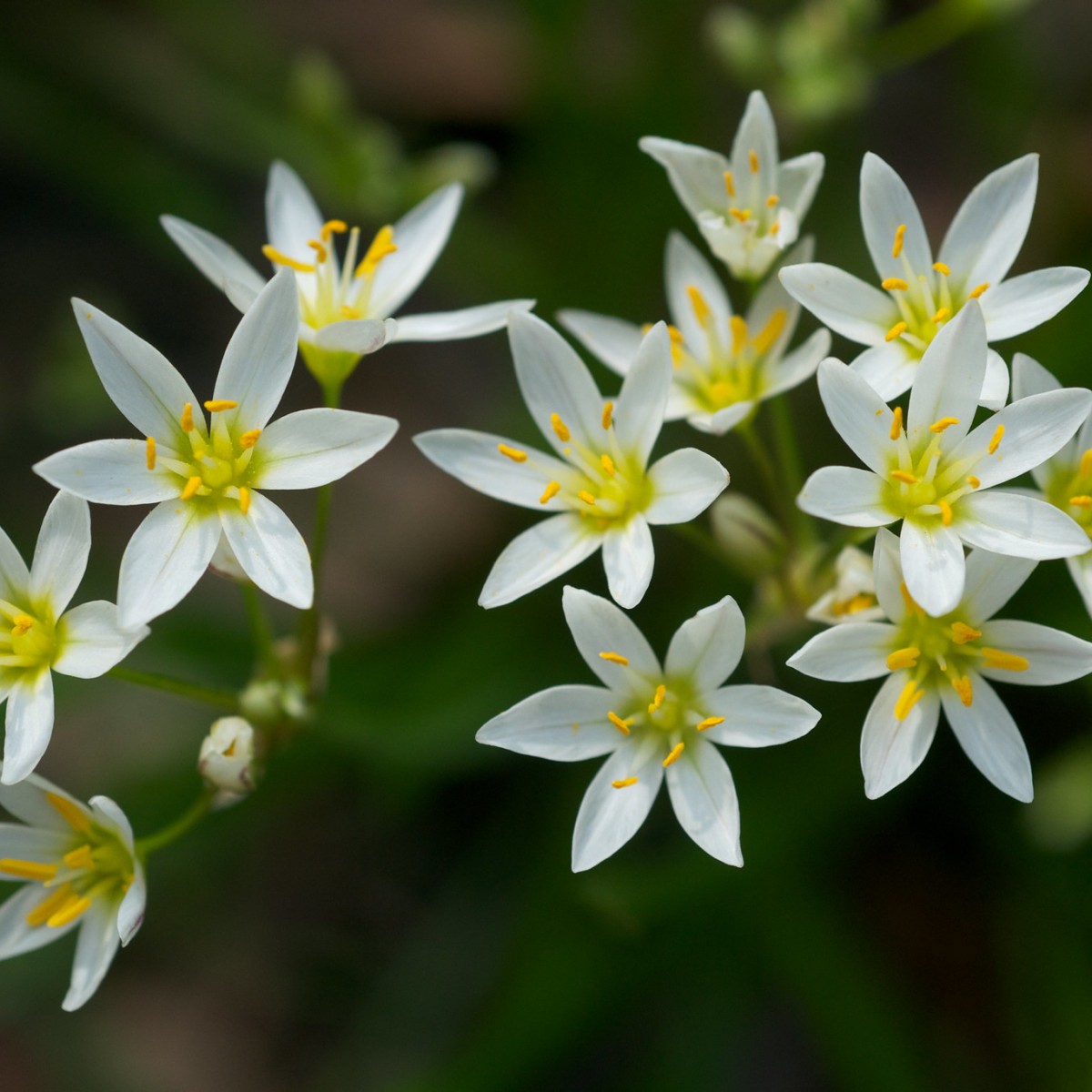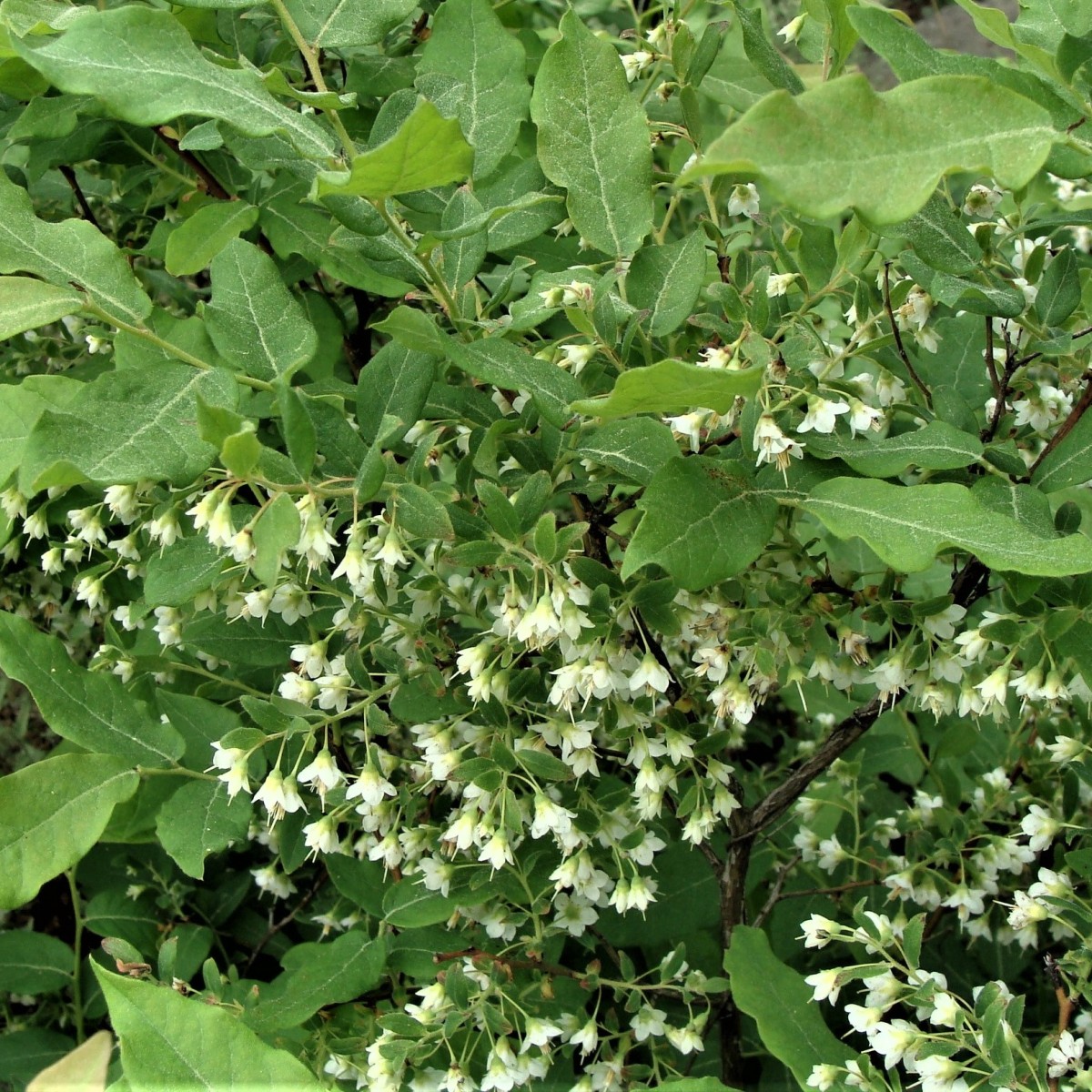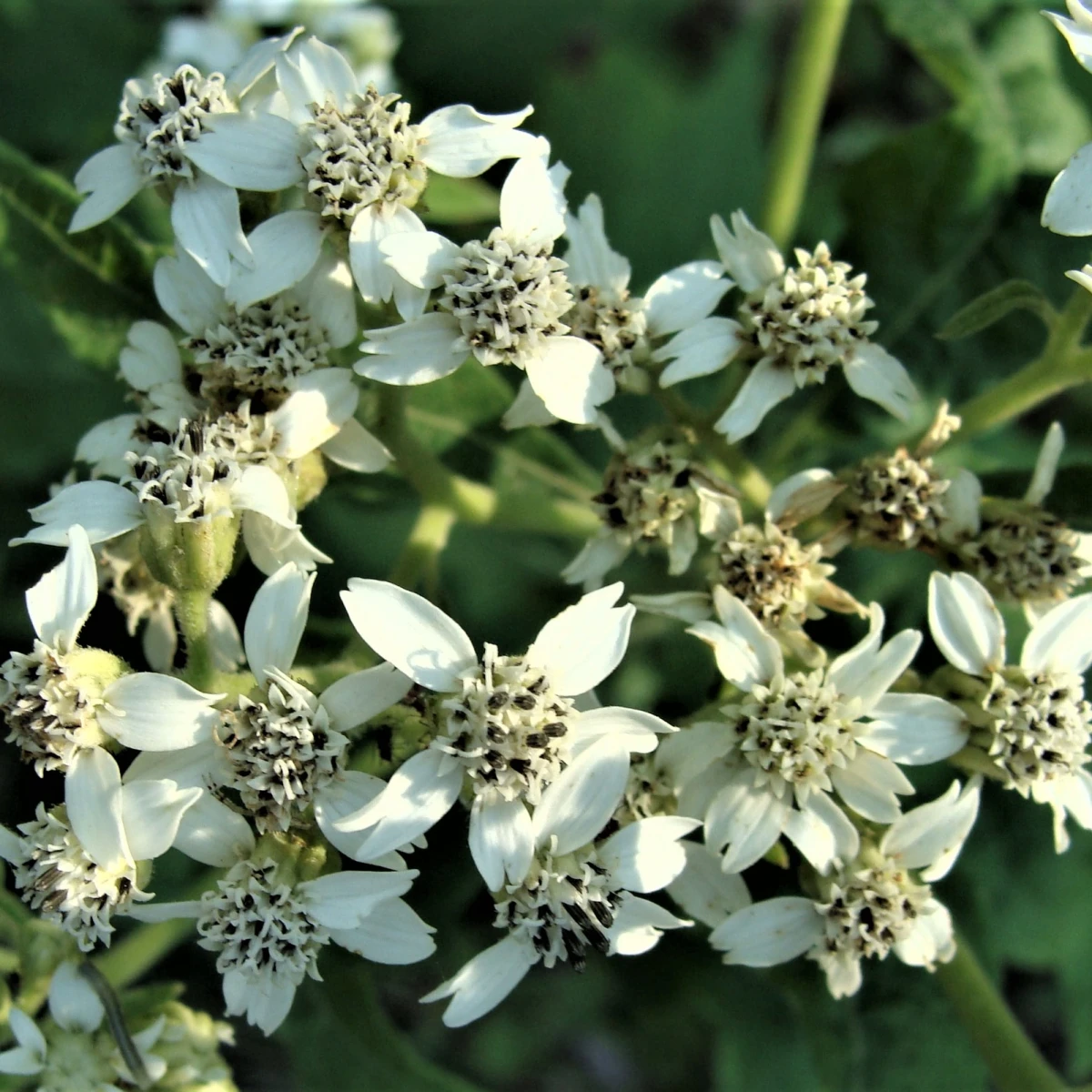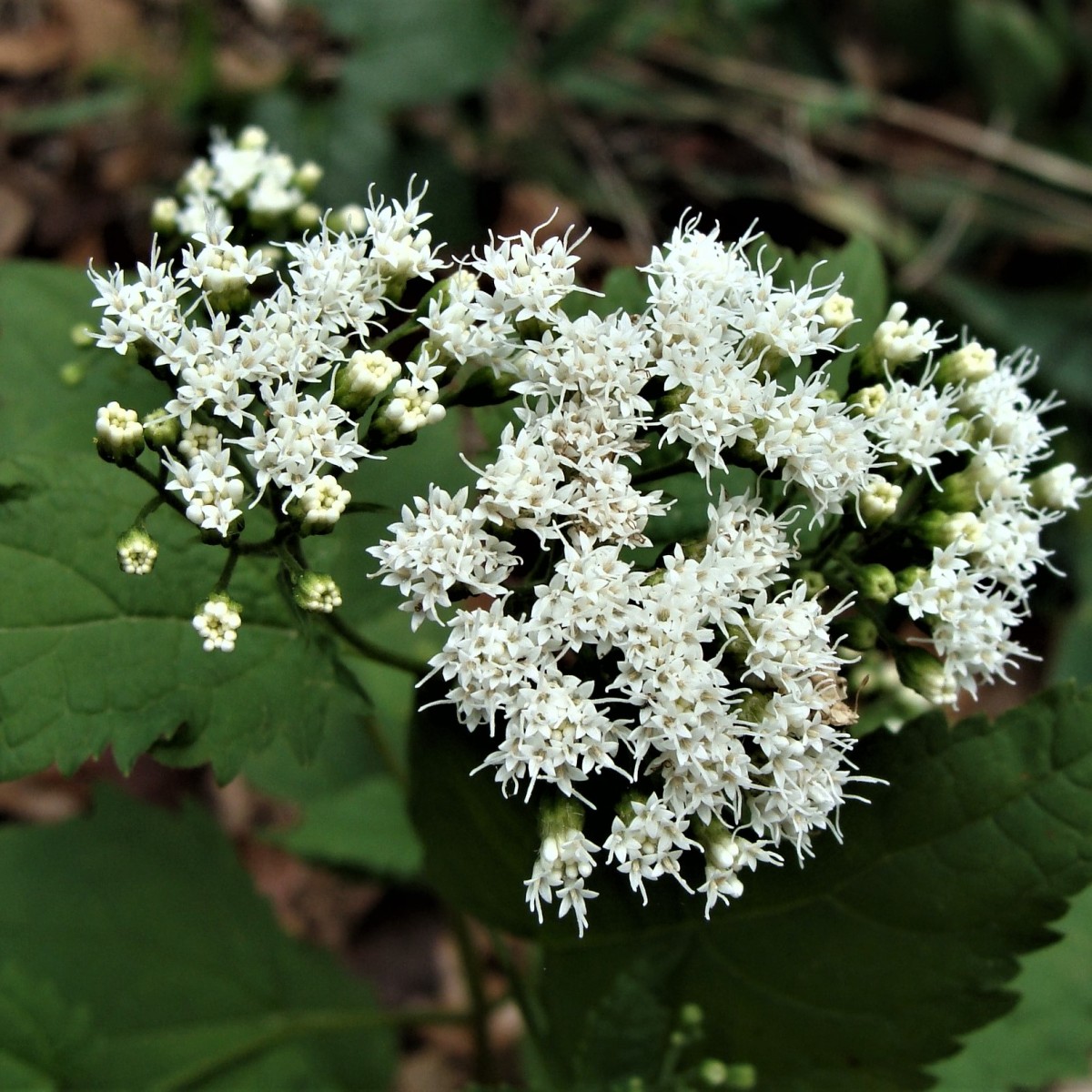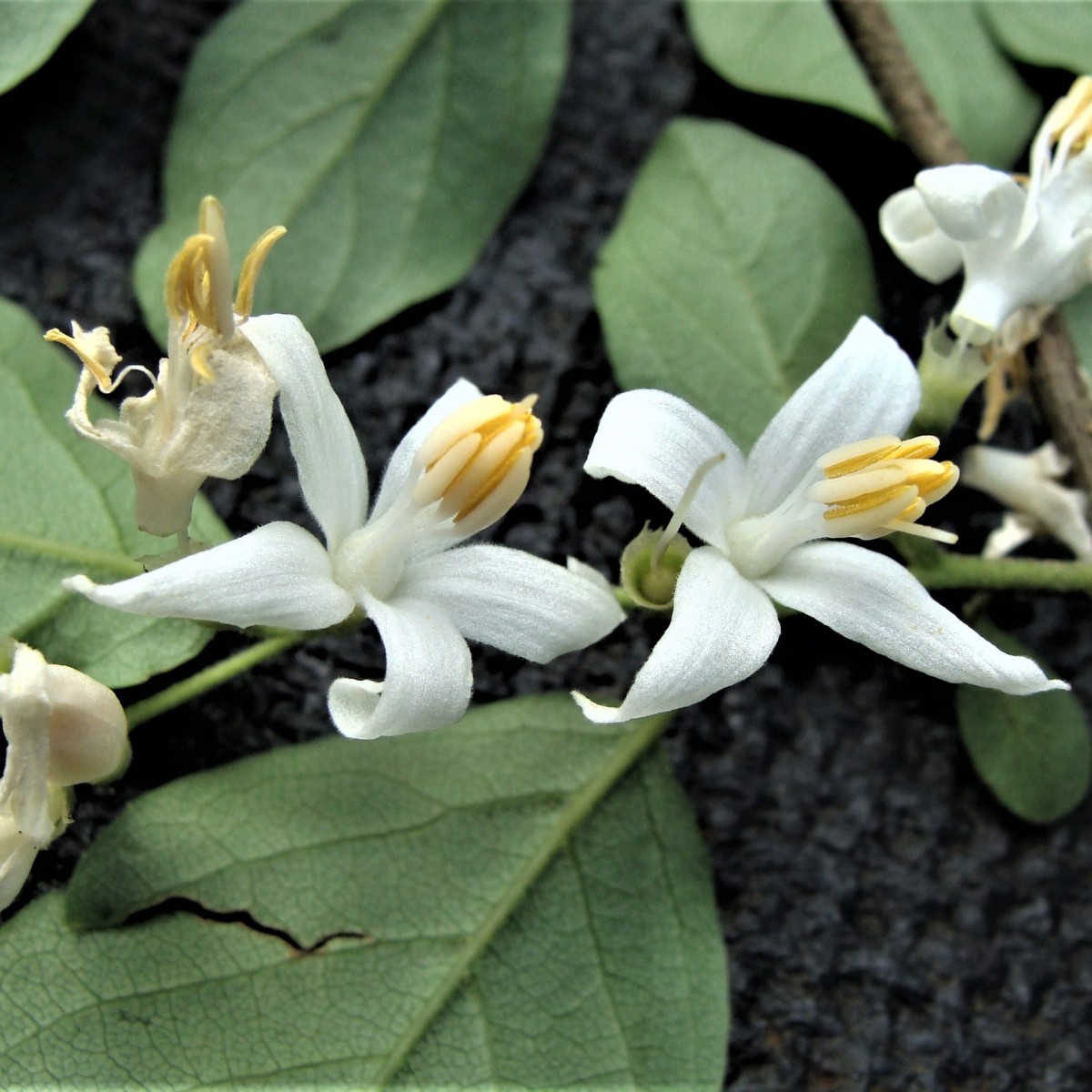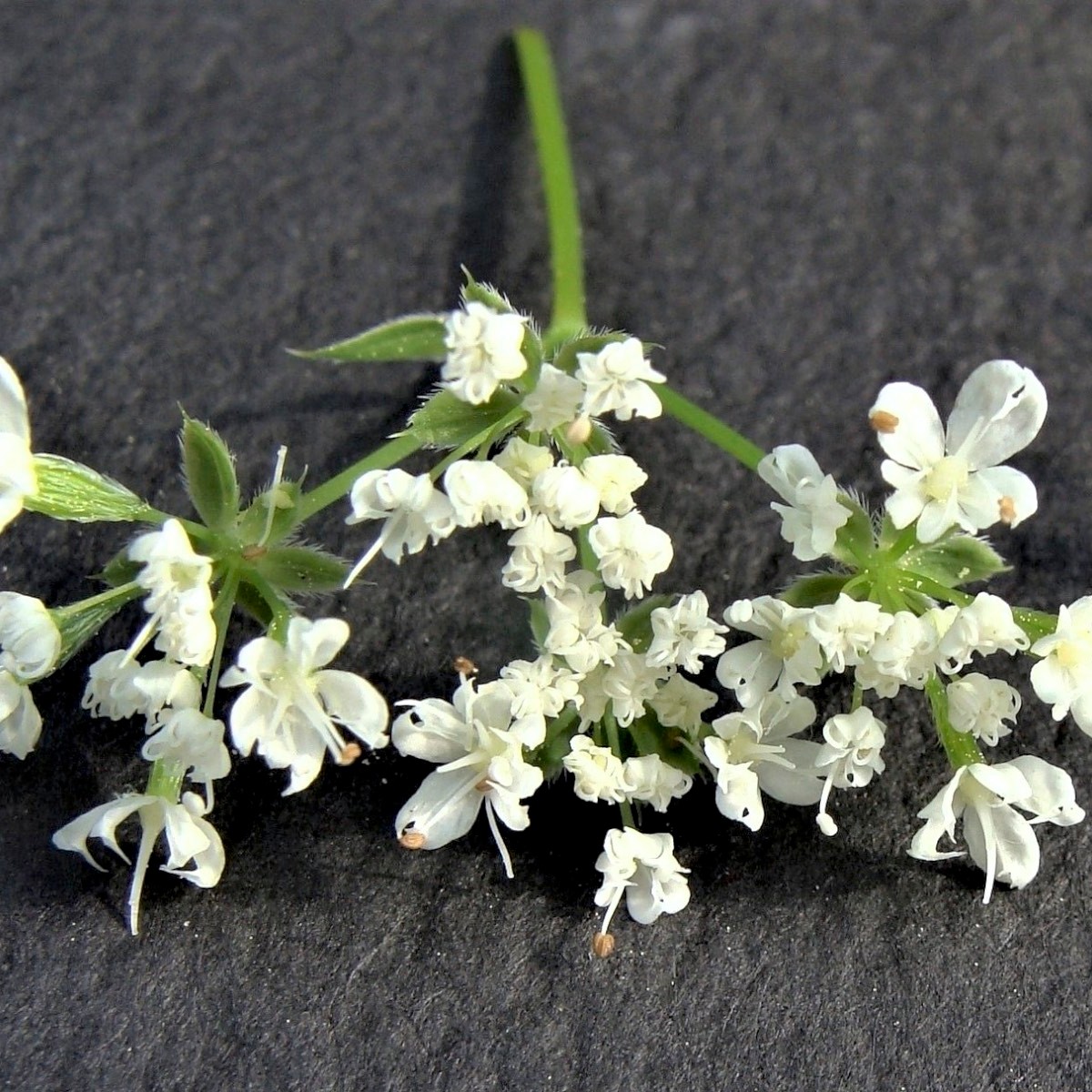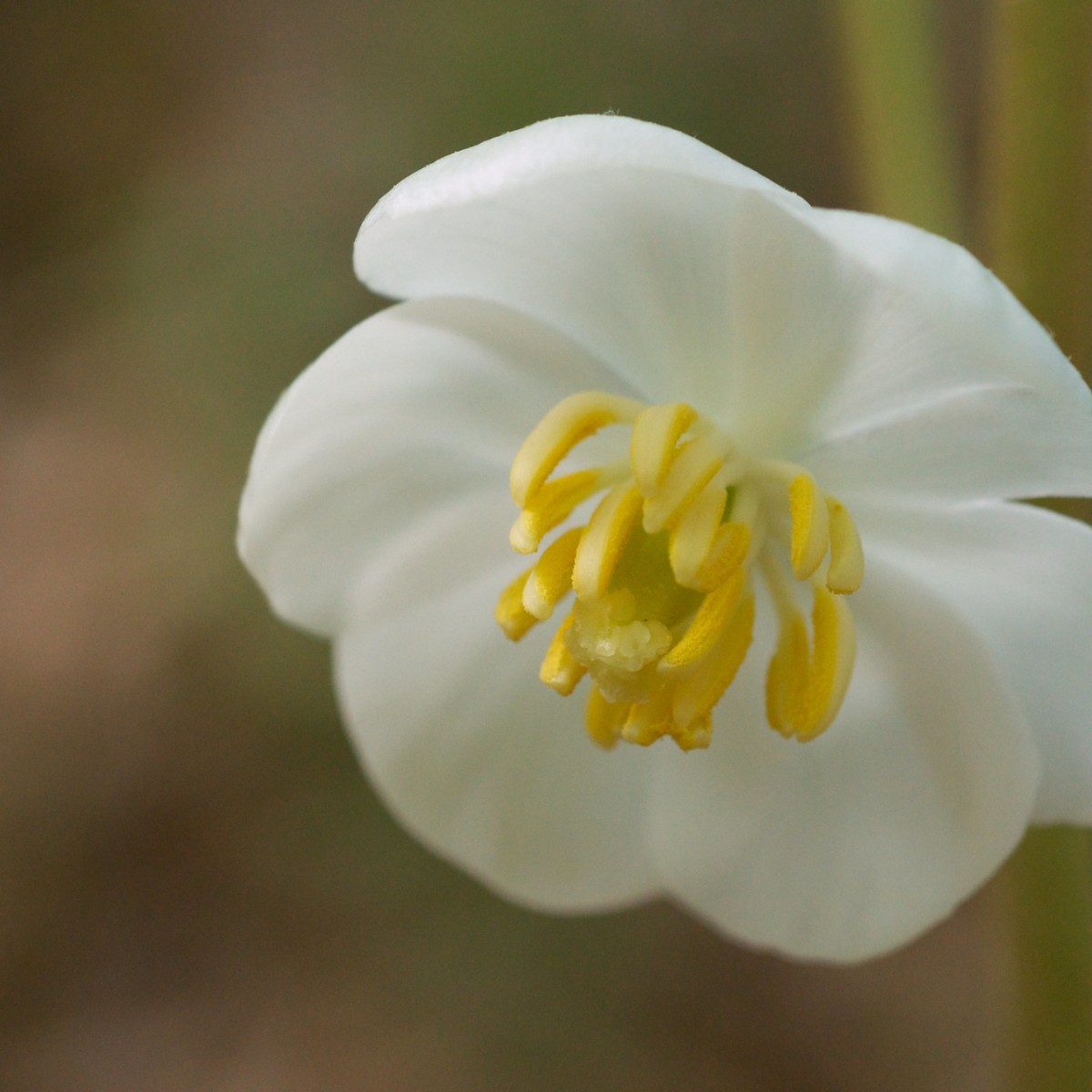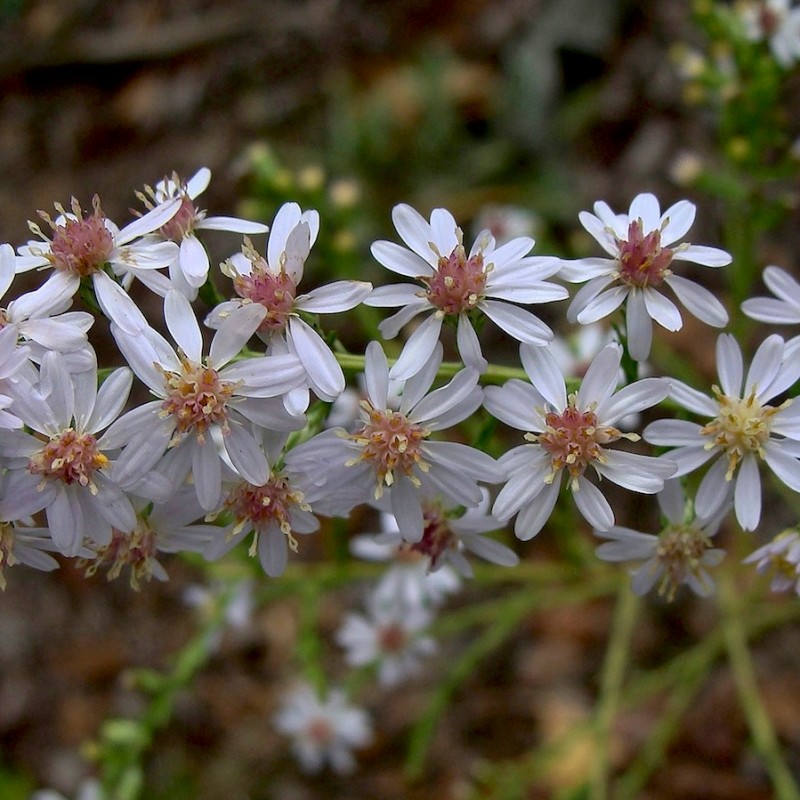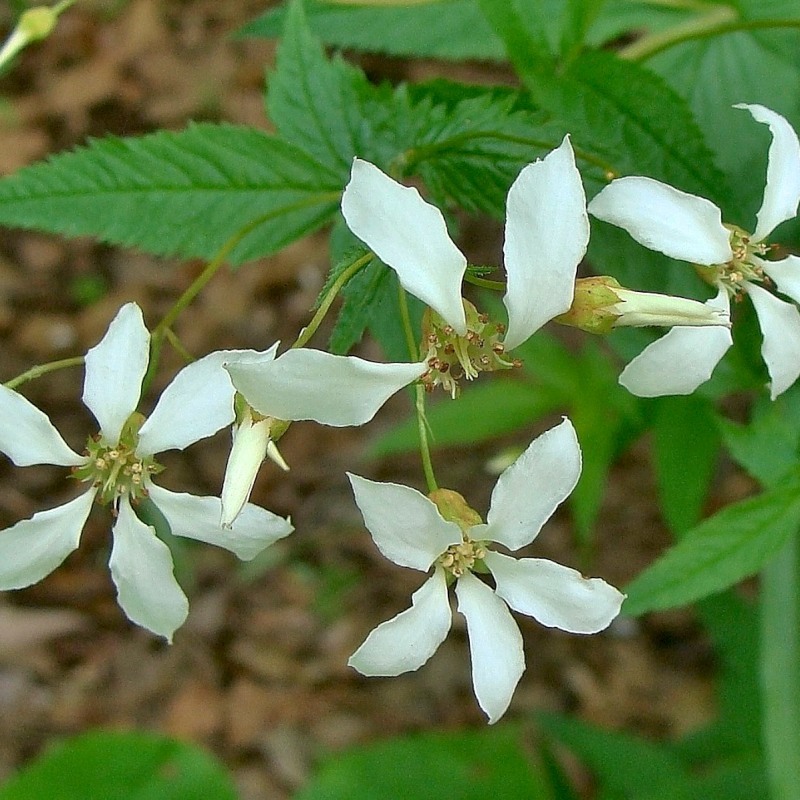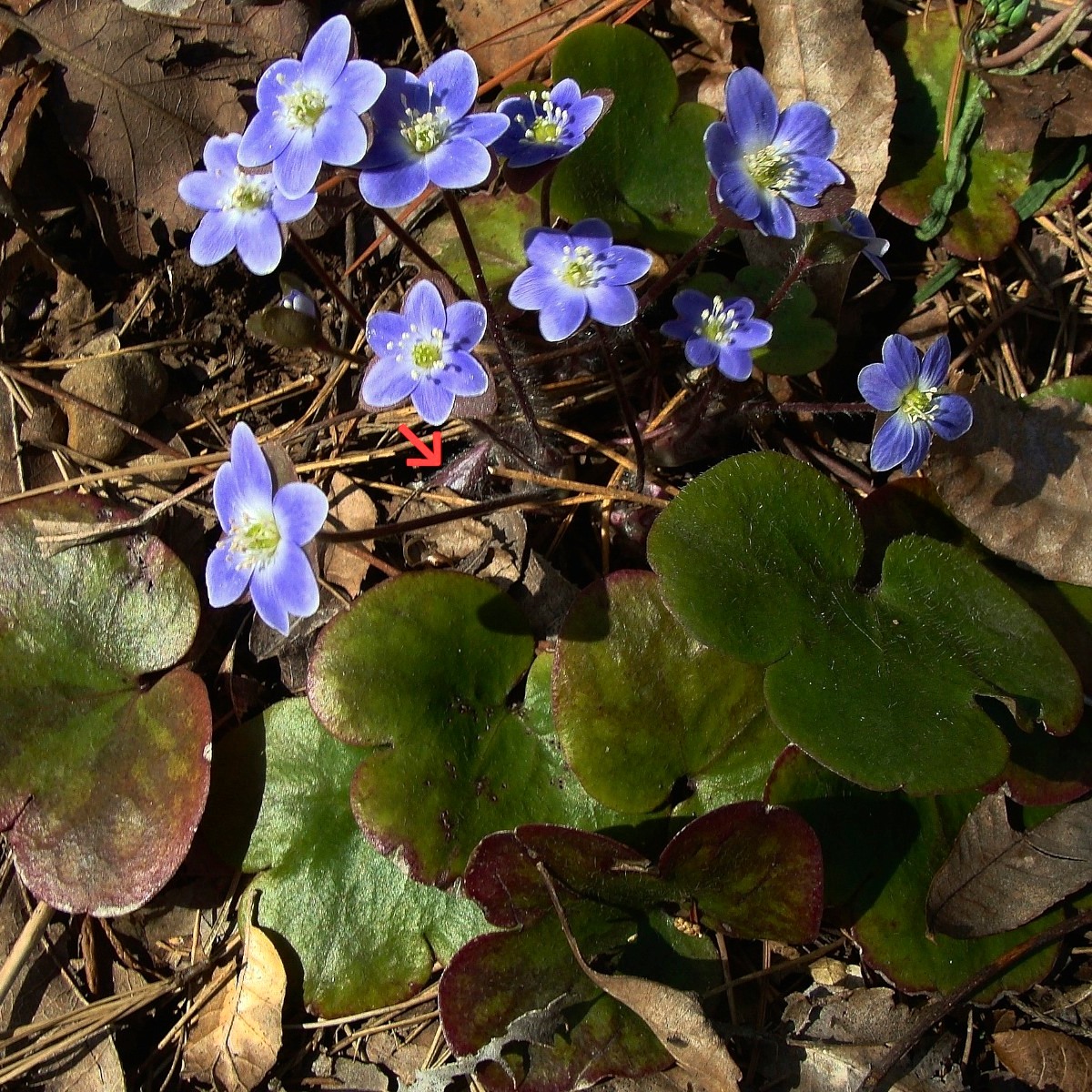Know Your Natives – White-Leaf Mountain Mint
White-Leaf Mountain Mint (Pycnanthemum albescens) of the Mint (Lamiaceae) family is a tall, upright perennial forb with a strong minty scent and has an open, gangly structure. The genus name is based on Greek words for dense (pyknos) and flower (anthos) in reference to its flower clusters. The specific epithet…
Know Your Natives – White Wand Beardtongue
White Wand Beardtongue (Penstemon tubiflorus; also sometimes spelled P. tubaeflorus) of the Plantain (Plantaginaceae) family, formerly of the Figwort (Scrophulariaceae) family, has sparsely leafed, erect stems bearing an elongate inflorescence of white tubular flowers. There is some disagreement on the exact etymology of the genus name. It may be based…
Know Your Natives – Wild Strawberry
Wild Strawberry (Fragaria virginiana) is an evergreen plant which produces scarlet strawberries* with achenes embedded in pits. The genus name derives from the Latin word “fragum” in reference to the fragrance of mature strawberries. The specific epithet refers to the state from which the species was originally collected and described.…
Know Your Natives – Rough Leaf Dogwood
Rough Leaf Dogwood (Cornus drummondii) of the Dogwood (Cornaceae) family is a small, deciduous tree with opposite leaves, open clusters of small white flowers, and striking, decorative white fruit. The genus name derives from the Latin for “horn” in apparent reference to the hardness of the wood. The specific epithet…
Know Your Natives – Ozark Mock Orange
Ozark Mock Orange (Philadelphus pubescens) of the Hydrangea (Hydrangeaceae) family, formerly of the Saxifrage (Saxifragaceae) family, is a deciduous shrub with bold, showy, four-petaled white flowers. The genus name is said to honor Ptolemy II Philadelphus, pharaoh of Egypt, 283-246 BC. The specific epithet is Latin for “downy.” The common…
Know Your Natives – Hairy Mock Orange
Hairy Mock Orange (Philadelphus hirsutus) of the Hydrangea (Hydrangeaceae) family, formerly of the Saxifrage (Saxifragaceae) family, is a deciduous shrub with rather large, showy, four-petaled white flowers. The genus name is said to honor Ptolemy II Philadelphus, pharaoh of Egypt (283-246 BC). The specific epithet is Latin for “hairy.” The…
Know Your Natives – Hairy Bush Clover
Hairy Bush Clover (Lespedeza hirta) of the Pea or Legume (Fabaceae) family is a perennial herb with stems to 3+ feet tall, bearing tightly clustered racemes of small creamy white flowers. The genus name is dedicated to Vicente Manuel de Cespedes (an early botanical text misspelled his name as “de…
Know Your Natives – Slender Mountain Mint
Slender Mountain Mint (Pycnanthemum tenuifolium) of the Mint (Lamiaceae/Labiatae) family is a rhizomatous plant with narrow, linear leaves that give the plant an attractive, airy appearance. The genus name is based on Greek words for “dense” and “flower.” The specific epithet is from the Latin for “slender leaved.” The species…
Know Your Natives – Late Boneset
Late Boneset (Eupatorium serotinum) of the Aster, Sunflower, or Composite (Asteraceae) family is a tall herbaceous perennial with small, clustered, whitish flowerheads that lack ray florets. The genus name recognizes Mithridates Eupator who invented a “universal antidote” against poisoning and is said to have used a species of the genus…
Know Your Natives – Rattlesnake Master
Rattlesnake Master (Eryngium yuccifolium) of the Parsley or Carrot (Apiaceae) family is a tall perennial with distinctive ovoid flower heads. The genus name is based on the ancient Greek name used by Theophrastus for a prickly plant of the Mediterranean region. The specific epithet is Latin for “yucca-leaved”––morphologically true, although…
Know Your Natives – Ouachita Hedge-Nettle
Ouachita Hedge-Nettle (Stachys iltisii*) of the Mint (Lamiaceae) family is a clonal herbaceous perennial with a spike-like inflorescence of two-lipped, white flowers with prominent purple blotches. The genus name is from the Greek for “an ear of wheat” in reference to the spike-like inflorescence. The specific epithet honors botanist Hugh…
Know Your Natives – Arkansas Beardtongue
Arkansas Beardtongue (Penstemon arkansanus) of the Plantain (Plantaginaceae) family, formerly of the Figwort (Scrophulariaceae) family, has showy white tubular flowers with a fifth stamen that is sterile, typically bearded (pubescent), and tonguelike in form, a hallmark of this large genus. The name Penstemon derives from the Greek words “penta” (five)…
Know Your Natives – Long-Flower Cornsalad
Long-Flower Cornsalad (Valerianella longiflora) of the Cornsalad (Valerianaceae) family is an intruigingly branched, herbaceous annual with white flowers with long purple floral tubes. The genus name is the diminutive of Valeriana, the type genus of the Valerianaceae, a name honoring the Roman emperor Valerianus. The specific epithet refers to the…
Know Your Natives – Rue-Anemone
Rue-Anemone (Thalictrum thalictroides; formerly Anemonella thalictroides) of the Buttercup (Ranunculaceae) family is a small, perennial, woodland ephemeral with an umbellate inflorescence of white to pink flowers. The genus name is the Latin form of the Greek word thaliktron, used in ancient times to describe some meadow-rues, possibly in reference to…
Know Your Natives – Black Nightshade
Black Nightshade (Solanum ptychanthum) of the Nightshade Family (Solanaceae) is a common weedy native with small white flowers and black berries. The genus name, meaning “quieting,” is the classical Latin name for the nightshades, in reference to the narcotic properties of some species of the genus.* The specific epithet is…
Know Your Natives – Carolina Horse Nettle
Carolina Horse Nettle (Solanum carolinense) of the Nightshade (Solanaceae) family is a toxic* perennial with attractive flowers and fruit and piercing prickles. The genus name is Latin for “quieting” in reference to the narcotic properties of some species. The specific epithet suggests that Linnaeus, who named the species, examined a…
Know Your Natives – Canada Rockcress
Canada rockcress (Borodinia canadensis*) of the Mustard (Brassicaceae/Cruciferae) family has small white flowers and long pendent bean-like fruits. The genus name most likely commemorates the Russian botanist Ivan Parfenievich Borodin (1847-1930) who founded the Russian Botanical Society. The specific epithet denotes the species’ occurrence in eastern Canada. In the U.S.,…
Know Your Natives – Spring-Beauty
Spring-beauty (Claytonia virginica), traditionally treated as a member of the Purslane (Portulacaceae) family but more recently as a member of the Miner’s-lettuce (Montiaceae) family, is a widespread, common, native wildflower, a perennial herb with lovely white, pink-veined flowers. The genus name honors John Clayton, one of Colonial America’s earliest botanists.…
Know Your Natives – Two-Wing Silverbell
Two-wing silverbell (Halesia diptera) of the Storax (Styracaceae) family is one of several understory trees in the family with pendant showy white flowers. The genus name recognizes English botanist Stephen Hales who authored Vegetable Staticks* in 1727. The specific epithet is based on Greek words for “two-winged” in reference to…
Know Your Natives – Water-willow
Water-willow (Justicia americana) of the Acanthus (Acanthaceae) family is an herbaceous aquatic perennial with willow-like leaves. The genus name recognizes James Justice, an 18th-century Scottish author of horticultural books. The specific epithet denotes the plant’s area of primary occurrence. In the U.S., water-willow occurs primarily from eastern Oklahoma and Kansas…
Know Your Natives – Ninebark
Ninebark (Physocarpus opulifolius)* of the Rose (Rosaceae) family is a large shrub which bears tight clusters of small white flowers. The genus name, from Greek words for “bladder” and “fruit,” refers to the inflated carpels of the fruit. The specific epithet, from Latin, compares the leaves to those of Viburnum opulus.…
Know Your Natives – Wild Quinine
Wild quinine (Parthenium integrifolium) of the Aster, Sunflower or Composite (Asteraceae) family is an herbaceous perennial with frosty composite flowerheads. The genus name is from the Greek word parthenos, for virgin––only the pistillate ray florets are fertile. The specific epithet, from Latin, means “entire-leaved,” meaning undivided, although the leaf margins…
Know Your Natives – Crow Poison
Crow poison (Nothoscordum bivalve) of the Onion (Alliaceae) family (formerly of the Lily (Liliaceae) family) resembles a wild onion and is often called “false garlic,” but the species has neither garlic nor onion scent or taste. The genus name is actually derived from Greek words for “false” and “garlic.” The…
Know Your Natives – Deerberry
Deerberry (Vaccinium stamineum) of the Heath (Ericaceae) family is a medium-sized deciduous shrub that has small bell-shaped flowers with flared corolla lobes. The species occurs from east Texas and Oklahoma, northeast to the Atlantic and Gulf Coasts. In Arkansas, it occurs statewide except for some portions of the Mississippi Alluvial…
Know Your Natives – Yarrow
Yarrow (Achillea millefolium) of the Sunflower, Aster or Composite (Asteraceae) family has distinctive, highly dissected, frilly leaves. The species, the only Arkansas member of the genus Achillea, is native to North America, Asia, and Europe––one of the widest worldwide ranges among the flowering plants. It occurs across almost the entire…
Know Your Natives – White Crownbeard
White crownbeard or white wingstem (Verbesina virginica) of the Aster, Sunflower, or Composite (Asteraceae) family has tall winged stems with domed clusters of white flower heads. In the U.S., it is found primarily from central Texas up through southeast Kansas, across to Maryland and thence to the Atlantic and Gulf…
Know Your Natives – White Snakeroot
White snakeroot (Ageratina altissima*), formerly Eupatorium rugosum, of the Aster, Sunflower, or Composite (Asteraceae ) family has a multitude of small white flowerheads late in the growing season. It occurs from Texas to eastern North Dakota, across all states to the Atlantic and Gulf Coasts, but of limited occurrence in…
Know Your Natives – American Snowbell
American snowbell or storax (Styrax americanus) of the Storax (Styracaceae) family is a large deciduous shrub with bell-shaped snowy-white flowers. The genus name is the ancient Greek name for a European species, Styrax officinalis. The specific epithet refers to the native range of the species. In the U.S., it occurs from…
Know Your Natives – Aniseroot
Aniseroot (Osmorhiza longistylis) of the Carrot (Apiaceae) family is a herbaceous erect perennial that has pleasantly aromatic roots. It occurs across most of the U.S. from New Mexico to Montana, thence east to the Gulf and Atlantic Coasts, with the exception of Louisiana and Florida. In Arkansas, the species occurs…
Know Your Natives – Mayapple
Mayapple (Podophyllum peltatum) of the Barberry (Berberidaceae) family is an herbaceous perennial that has one or two large leaves per stalk. The genus name is from Greek words for “foot” and “leaf”, in reference to the appearance of the leaves. The specific epithet, from Latin, is a reference to the…
Know Your Natives – Sparkleberry
Sparkleberry (Vaccinium arboreum) of the Heath (Ericaceae) family is a blueberry that adds persistent color to the fall-foliage palette. The genus name is ancient, but of no clear meaning–possibly from the Latin vaccinus, “of cows”. The specific epithet is from the Latin, meaning “tree-like”. Sparkleberry occurs from Texas to Kansas…
Know Your Natives – Arrowhead
Arrowhead (Sagittaria platyphylla) of the Water Plantain (Alismataceae) family is an aquatic perennial of shores and marshes. It is one of eight Sagittaria species found in Arkansas that have “arrowhead” as their common name (see below). The genus name is from the Latin sagitta, an arrow, for the sagittate (arrow-shaped) leaves…
Know Your Natives – Fly poison
Fly poison (Amianthium muscitoxicum*) of the Bunchflower (Melanthiaceae) family, the only species in the genus, bears white flowers that change to green. The genus name originates from Greek words for “pure” and “flower”. The specific epithet is from Latin words for “fly” and “poison”. In the U.S., fly poison occurs…
Know Your Natives – Foxglove Beardtongue
Foxglove beardtongue (Penstemon digitalis) of the Plantain (Plantaginaceae) family, formerly of the Figwort (Scrophulariaceae) family, is the largest of five white-flowered beardtongues in Arkansas. It is found throughout much of the eastern U.S. The genus name is from Greek words translating to “five stamens.” The specific epithet refers to the…
Know Your Natives – Wild Comfrey
Wild comfrey (Cynoglossum virginianum) of the Borage (Boraginaceae) family is a short perennial with large leaves and pale blue flowers. In the US, it occurs from Texas to Illinois to New York to the Atlantic and Gulf Coasts. In Arkansas, it occurs statewide except for some areas of the Mississippi…
Know Your Natives – Downy Serviceberry
Downy serviceberry (Amelanchier arborea) of the Rose (Rosaceae) family is a small tree or large shrub that produces showy white flowers very early in spring. The genus name likely originates from a common name of the type species of the genus, Amelanchier ovalis, a European species. The specific epithet translates…
Know Your Natives – Rusty Blackhaw
Rusty blackhaw (Viburnum rufidulum) of the Arrow-wood (Adoxaceae) family, formerly of the Honeysuckle (Caprifoliaceae) family, is a small deciduous tree or large shrub (referred to as “tree” herein) with a year-round attractive appearance. It occurs in the U.S. from Texas to Kansas to Ohio to Virginia and thence into states…
Know Your Natives – Drummond’s Aster
Drummond’s aster (Symphyotrichum drummondii) of the Aster (Asteraceae) family is a herbaceous perennial with disk flowers that change color with age. Preferred habitats are partially sunny upland sites in open deciduous woodlands and woodland borders along streams and roads. This aster occurs from Texas and Alabama north to Minnesota and…
Know Your Natives – White Leafcup
White leafcup (Polymnia canadensis) of the Aster (Asteraceae) Family is a coarse, short-lived perennial. The genus name is in reference to the Greek Muse Polymnia (also spelled Polyhymnia), goddess of music, song and dance. The specific epithet refers to the plant’s occurrence in Canada. In the U.S., its greatest concentration…
Know Your Natives – Whorled Milkweed
Whorled Milkweed (Asclepias verticillata) in the Dogbane (Apocynaceae) family, formerly in the Milkweed (Asclepiadaceae) family, is a perennial herbaceous forb. The genus name relates to the Greek god of medicine (Asklepios, alternatively spelled Asclepius). The specific epithet is from a Latin word meaning “whorled”, in reference to the plant’s leaf…
Know Your Natives – New Jersey Tea
New Jersey tea (Ceanothus americanus) of the Buckthorn (Rhamnaceae) Family is a small, deciduous, thorn-free shrub. The genus name originates from a Greek word for “spiny plant” or a Latin word for “thistle”. The specific epithet relates to its occurrence in the Americas. In the U.S., it is found from…
Know Your Natives – Western Daisy
Western Daisy (Astranthium ciliatum) (formerly Astranthium integrifolium*), of the Aster (Asteraceae) family, is an annual species with daisy-like flower heads. In the U.S., it is found in Arkansas, Oklahoma, Texas, southern Nebraska and southwestern Missouri with greatest concentrations in eastern Oklahoma and western Arkansas. The genus Astranthium comprises about a…
Know Your Natives – Dwarf Larkspur
Dwarf larkspur (Delphinium tricorne) of the Buttercup (Ranunculaceae) family has distinctive early spring flowers that are often dark bluish-purple (or sometimes white). Other common names include spring larkspur and rock larkspur. This species is typically found in rich alluvial deciduous woods and wooded rocky slopes in shady to partially sunny sites…
Know Your Natives – Arkansas Yucca
Arkansas yucca (Yucca arkansana) of the Agave (Agavaceae) family, formerly of the Lily (Liliaceae) family, an evergreen shrub, occurs in Texas, Oklahoma, southeastern Kansas, southern Missouri and Arkansas. In Arkansas, it occurs throughout much of the Interior Highlands. The genus name originates from a misapplication by Carl Linnaeus in 1753 of…
Know Your Natives – Patridgeberry
Partridgeberry (Mitchella repens) of the Madder (Rubiaceae) family is an evergreen perennial with a trailing growth habit. It occurs in the U.S. from Texas to Oklahoma to Missouri to Minnesota thence to the Atlantic and Gulf Coasts. It occurs throughout most of Arkansas except for portions of the Mississippi Alluvial…
Know Your Natives – Evening Rain-Lily
Evening rain-lily (Cooperia drummondii, also known variously by some athorities as Cooperia chlorosolen or Zephyranthes chlorosolen) of the Amaryllis (Amaryllidaceae) family, formerly of the Lily (Liliaceae) family, occurs in the south-central United States from New Mexico to Kansas to Alabama and then thence south to the Gulf Coast and into…
Know Your Natives – Sweet Everlasting
Sweet everlasting, Pseudognaphalium obtusifolium (formerly Gnaphalium obtusifolium), of the Aster (Asteraceae) family is an herbaceous annual. In the U.S., it occurs from Texas to Nebraska to Minnesota and thence east and south to the coasts, including most of Arkansas. Natural habitats are mesic to dry sandy areas in prairies, glades, open…
Know Your Natives – White Oldfield Aster
White oldfield aster (Symphyotrichum pilosum), formerly Aster pilosus, a herbaceous perennial of the Aster (Asteraceae) family, occurs from Texas to South Dakota and Minnesota thence to the Atlantic and Gulf Coasts. In Arkansas, this aster occurs statewide and is one of 22 species of aster (Symphyotrichum) konwn to occur in the…
Know Your Natives – Red-Ring Milkweed
Red-ring milkweed (Asclepias variegata) of the Dogbane (Apocynaceae) family, formerly of the Milkweed (Asclepiadaceae) family, occurs in the U.S. from eastern Texas and Oklahoma to Illinois and east and south to the borders. It occurs throughout much of Arkansas except for small areas in northwest and east-central parts of the…
Know Your Natives – American Ipecac
American ipecac (Gillenia stipulata; previously Porteranthus stipulatus), of the Rose (Rosaceae) family occurs in the U.S. from northeast Texas to southeast Kansas, to Michigan, New York and south to Georgia. In Arkansas, this species is found mostly statewide except for portions of the Mississippi Alluvial Plain. The genus name honors a German physician…
Know Your Natives – Cream Wild Indigo
Cream wild indigo (Baptisia bracteata*), of the Pea (Fabaceae) family occurs from the Midwest to Texas and the Southeastern states except for Florida. It is also reported from Connecticut and New Jersey. In Arkansas, it occurs mostly statewide except for some portions of the Mississippi Alluvial Plain. Another common name is long-bract wild…
Know Your Natives – Robin’s-Plantain
Robin’s-plantain (Erigeron pulchellus var. pulchellus) of the Aster (Asteraceae) family has been documented in the U.S. from eastern Texas to southeastern Kansas to Minnesota thence east and south to the nation’s borders (although it is rare in Florida and restricted to the panhandle).* In Arkansas, it has been documented throughout much of the…
Know Your Natives – Dutchman’s Breeches
Dutchman’s breeches (Dicentra cucullaria) of the Poppy (Papaveraceae) family, formerly of the Fumitory (Fumariaceae) family, is found throughout much of the eastern U.S. from North Dakota to Maine southward to Oklahoma and South Carolina. Curiously, it is also found in Washington, Oregon and Idaho. In Arkansas, Dutchman’s breeches is found primarily throughout the Ozark Mountains, but it…
Know Your Natives – Cut-Leaf Toothwort
Cut-leaf toothwort (Cardamine concatenata) of the Mustard (Brassicaceae) family occurs throughout the eastern U.S., westward to eastern Texas, eastern South Dakota, but is uncommon in Georgia and Florida at the southeastern extent, as well as in the northeastern reaches of New England. In Arkansas, the species occurs in upland areas across the…
Know Your Natives – Round-Lobe Hepatica
Round-lobe hepatica (Anemone americana) of the Buttercup (Ranunculaceace) family, also called liverleaf*, is one of the first non-woody plants to bloom in spring. The species is found in the U.S. primarily from Mississippi, Alabama, and northern Florida, north through New England, and then west through the Great Lakes region. A separate…
Know Your Natives – White avens
White avens (Geum canadense) of the Rose (Rosaceae) family occurs in the U.S. from Texas to Nebraska to Montana thence to the eastern and southern borders with the exception of Florida. In Arkansas, it is found throughout the state. Habitats include lightly shaded to partially sunny, moist deciduous woodlands, woodland…

